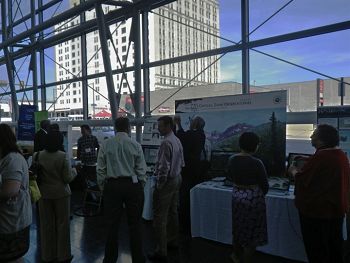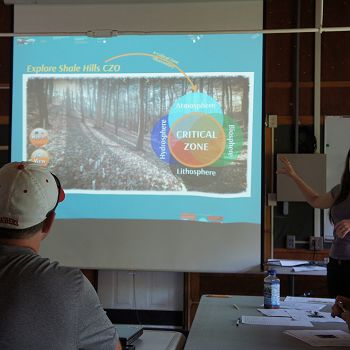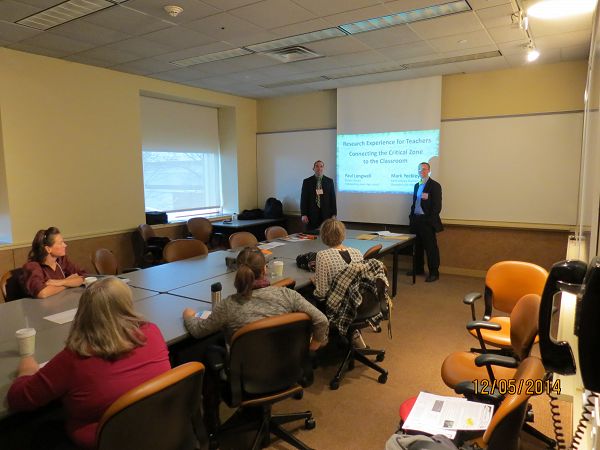K-12 Education
A national-scale CZO education and outreach effort has begun.
The CZOs participate in a variety of organizational forums to develop a focused and effective education and outreach presence.
Anthony Aufdenkampe, Susan Gill (Stroud Water Research Center, Christina River Basin CZO), Douglas Jerolmack (University of Pennsylvania, Luquillo CZO) and Timothy White (CZO national coordinator) engage U.S. Represenative Chaka Fattah during his visit to the CZO booth at the 2011 STEM conference in Philadelphia.
Educational Resources (examples for K-12)
- Observe and record Earth surface and environmental phemomena using their senses.
- Question their observations and hypothesize cause-effect relationships, functions of particular structures, and predictions of how a property or process may change over time or across space.
- Describe the main parts of the water cycle in and around a tree.
- Become familiar with proportions of water in each part of the cycle, depending on seasons and location.
- Students use ecological data collected at the El Yunque National Forest by the Luquillo Critical Zone Observatory, Luquillo LTER and USGS Water to create a project that presents data in a non-traditional ways.
- Students create data visualizations.
- Describe the relationship between GPR transmission-reflection delay times, wave speed of electromagnetic radiation, and soil depth. (HS-PS4-5)
- Interpret field data to infer the location of rocks, roots, and other point reflectors located in the subsoil. (HS-PS2-6)
- Compare time-lapse GPR field data with soil moisture measurements to describe the impact of surface rainfall on soil moisture changes at various depths. (HS-ESS2-5)

Grades K - 8
Notice & Wonder: Foundation for scientific Inquiry in the CZ
All Disciplines • Hydrology • SoilScience/Pedology
Activity • Lesson Plan
Learn how the words “I notice...” and “I wonder...” can spark an exploration of the Critical Zone. Dive into the question: "Where does water go when it rains?". This set of activities was developed for AGI Earth Science Week 2018.
Educational Objectives
After this activity, students will be able to:
NGSS Crosscutting Concepts: Cause and Effect - Mechanism and Explanation • Energy and Matter - Flows, Cycles, and Conservation • Structure and Function • Stability and Change
NGSS Science & Engineering Practices: Asking Questions and Defining Problems • Planning and Carrying Out Investigations • Engaging in Argument from Evidence
NGSS Disciplinary Core Ideas: ESS2 - Earth’s Systems
Audience: K-12
Observatory: National CZO
Author: Michelle Gilmore (University of California, Merced)
Funding: National Office of the Critical Zone Observatory Program
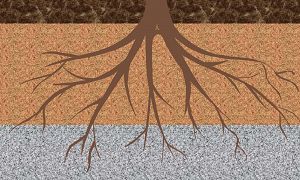
Grades K - 8
A tree's water cycle
Biology/Ecology • Hydrology • SoilScience/Pedology
Activity • Lesson Plan
Take a journey as water molecules moving throughout the tree water cycle.
Educational Objectives
By the end of this activity, students will be able to:
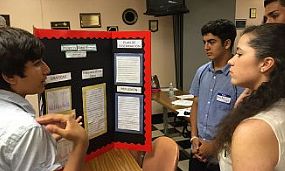
Grades 9 - 12
LTER/LCZO Schoolyard Data Jam
Biology/Molecular
Workshop • Project
The Luquillo LTER/CZO Data Jam invites high and middle school students to find interesting, non-traditional ways to present scientific data to non-scientist audiences.
Educational Objectives
NGSS Crosscutting Concepts: Patterns
NGSS Science & Engineering Practices: Asking Questions and Defining Problems • Analyzing and Interpreting Data • Obtaining, Evaluating, and Communicating Information
NGSS Disciplinary Core Ideas: ESS2 - Earth’s Systems
Audience: K-12
Observatory: Luquillo CZO
Author: Steven McGee (The Learning Partnership), Noelia Baez Rodriguez (UPR, Luquillo LTER), Miguel Leon (UPenn, LCZO), Bill McDowell (UNH, LCZO)
Funding: NSF CZO, NSF LTER
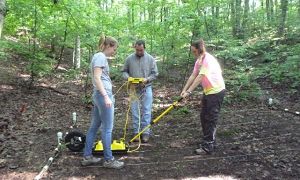
Grades 6 - 12
Ground Penetrating Radar - Monitoring Soil Moisture
Geophysics
Activity
This activity explores methods for visualizing and understanding the relationship between plant features (biosphere), the development of subsurface water flow pathways (hydrosphere and lithosphere), and variations in soil moisture content through time.
Educational Objectives
This activity explores methods for visualizing and understanding the relationship between plant features (biosphere), the development of subsurface water flow pathways (hydrosphere and lithosphere), and variations in soil moisture content through time. You will use data collected from the Shale Hills field site to accomplish the following objectives:
NGSS Crosscutting Concepts: Cause and Effect - Mechanism and Explanation
NGSS Science & Engineering Practices: Planning and Carrying Out Investigations • Obtaining, Evaluating, and Communicating Information
NGSS Disciplinary Core Ideas: PS2 - Motion and Stability: Forces and Interactions • PS4 - Waves and Their Applications in Technologies for Information Transfer • ESS2 - Earth’s Systems
Audience: K-12
Observatory: Shale Hills CZO
Author: Paul Longwell (2014 CZO RET)
Contact:
Funding: Financial support from NSF EAR #1263212: REU/RET Site: Collaborative Research: Introducing Critical Zone Observatory Science to Students and Teachers
Example activities
Outlined below are key examples of educational activities coordinated by the CZO National Office to engage K-12 teachers or administrators overseeing K-12 funding programs.
Many additional K-12 E/O activities are run by the CZO program, mostly led by individual Observatories. To see examples of those per-CZO efforts, select an observatory from the “Move laterally” menu above.”
AGI Earth Science Week
CZO researchers cooperated with the American Geosciences Institute's Earth Science Week since 2013, providing "hands on" learning exercises that are sent to more than 16,000 teachers nationwide.The CZO National Office intends for this cooperation to continue on an annual basis. More information is available in a 2014 News story and a 2015 News story (African Dust feeds the Puerto Rico ecosystem).
AGI hands-on learning exercises:
- Gulf of Mexico Hypoxia (Dead) Zone (1 MB pdf)
- LiDAR exercise for high school classrooms (4 MB pdf)
- Water resources management simulation (1 MB pdf)
- Paleoclimate influence on landscape evolution (1 MB pdf)
- The Past, Present & Future of the Valles Caldera (1MB pdf)
- Notice & Wonder: Foundation for Scientific Inquiry in the Critical Zone (1 MB pdf)
- The Influence of Dry Deserts on Tropical Rain Forests (1 MB pdf) | Online Version
CZO REU/RET program
Tim White, as national coordinator, and Susan Gill, Stroud Water Research Center education director, developed a successful Research Experience for Teachers (RET) program that places 2 secondary education teachers each at the Christina River Basin and Shale Hills CZOs during the summers of 2014 through 2016.
2016
RET, Lauren Smith, lead a secondary teachers workshop at Penn State University on the use of Virtual Field Experiences in a classroom. Smith led 10 participants in a lecture and series of discussions followed by a guided afternoon tour of the Shale Hills CZO by Tim White and Dave Eissenstat (PSU). The workshop concluded with an aquatic invertebrate exercise using Stroud Water Research Center's Leaf Pack Experiment Kit.
2015
A CZO Science Teaching Workshop, organized by two RETs and National Office collaborator Don Duggan-Haas, was held in State College, PA to provide K-12 teachers an introduction to CZ science through the creation and use of Virtual Fieldwork Experiences (VFEs).
RET Sharon Dykhoff developed a hydrology learning unit available through the Science Education Resource Center (SERC) entitled "The Case of the Muddy Water: Using Authentic Data to Investigate Impacts of Hydrofracturing." The objective of this lesson is to introduce the potential impacts of natural gas extraction through data analysis.
2014
Two teachers developed learning exercises and presented the results of their summer experience at the Pennsylvania State Teachers Association meeting in State College, PA on December 8, 2014.
REU/RET hands-on learning exercises:
Ground Penetrating Radar - Monitoring Soil Moisture (1 MB docx)
Carbon Storage Measurements in Forests (1 MB docx).
Paul Longwell (Hollidaysburg Area School District, PA) and Mark Yeckley (Glendale School District, PA), 2014 summer RETs at the Shale Hills CZO, present the results of their summer experience at the PA State Teachers Association meeting in State College, December 2014.
On-line Critical Zone Course
Tim White developed an on-line open-source course entitled 'Earth Surface Processes in the Critical Zone'. The course is formally offered through The Pennsylvania State University's Masters of Education in Earth Sciences program and aims to educate middle and high school teachers interested in incorporating Critical Zone science into their classroom curriculum. Course Home Page
GSA Short Course
As national coordinator, Tim White taught a short course entitled "Introduction to Critical Zone Science and Observatories" at the 125th anniversary meeting of the Geological Society of America in Denver in October 2013, a course that will be offered again at the GSA meeting in Vancouver, B.C., Canada in October 2014. CZO News Article
Earthscope Talk
The CZO national coordinator traveled to Arizona State University during February 2012 to the Education and Outreach summit organized by Earthscope, presenting a short talk on CZO efforts and engaging colleagues from a variety of NSF-sponsored science initiatives to learn and share. Earthscope blog
STEM Conference
CZOs were included in the NSF-sponsored national Science, Technology, Engineering and Mathematics (STEM) best practices conference at Drexel University in Philadelphia, PA on September 16, 2011, displaying large format posters, a stream table, and various on-line educational opportunities associated with the CZOs. CZO News Article
Paul Longwell (Hollidaysburg Area School District, PA) and Mark Yeckley (Glendale School District, PA), 2014 summer RETs at the Shale Hills CZO, present the results of their summer experience at the PA State Teachers Association meeting in State College, December 2014.
Siobhan Donnelly (Centre Learning Community Charter School, PA) explains the Critical Zone concept.
Participants sorted and collected data on invertebrates from nearby Shaver's Creek and Garner Run sites.
Associated Files
AGI 2020
(1 MB pdf)
Humans and Soil Change
AGI 2019
(1 MB pdf)
Make Your Own Landslide!
AGI 2018
(639 KB pdf)
Notice & Wonder: Foundation for Scientific Inquiry in the Critical Zone
AGI 2017
(264 KB pdf)
Gulf of Mexico Hypoxia (Dead) Zone
AGI 2016
(441 KB pdf)
The Past, Present & Future of the Valles Caldera
AGI 2015
(1 MB pdf)
The Influence of Dry Deserts on Tropical Rain Forests
AGI 2015 - supplement
(2 MB pdf)
Supplement - The Influence of Dry Deserts on Tropical Rain Forests. African_Dust_Supplementary
AGI 2015 - excel dataset
(534 KB xlsx)
Excel dataset - The Influence of Dry Deserts on Tropical Rain Forests. Rain_chemistry_data_AGI
AGI 2014
(1 MB pdf)
Water resources management simulation
ESW calendar 2014
(651 KB pdf)
Paleoclimate influence on landscape evolution
AGI 2013
(4 MB pdf)
LiDAR exercise for high school classrooms
RET 2014-1
(1 MB docx)
Ground penetrating radar - monitoring soil moisture
RET 2014-2
(1 MB docx)
Carbon storage measurements in forests
News
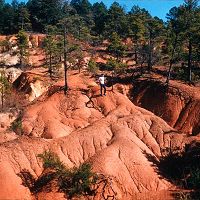
FEATURED NATIONALLY
K-12 Activity: Humans and Soil Change
19 Jul 2020 (National, Calhoun) - The activity familiarizes students with some of the environmental and human factors that contribute to accelerated rates of soil erosion.
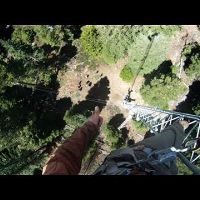
FEATURED
Southern Sierra CZO Videos
04 May 2020 (Sierra) - Onward California - University of California television spots showcase Southern Sierra CZO research
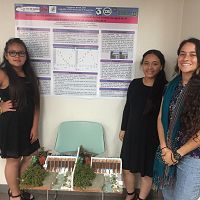
The Luquillo LTER/CZO Schoolyard Data Jam 2019
04 Sep 2019 (Luquillo) - The Luquillo LTER/CZO Schoolyard Data Jam 2019 was succesfully concluded Friday May 17th. Photos from the poster session and student created...
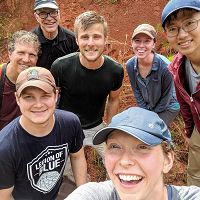
FEATURED
Field trip of Penn State students to the Calhoun, 6/7/2019
21 Aug 2019 (Calhoun) - Dan Markewitz and Dan Richter led a field trip on June 6-7, 2019 in the rain (perhaps 3") across the Calhoun CZO with Penn State students. We...

TeenShale evaluates Wallace Run near abandoned well using macroinvertebrate surveys
07 May 2019 (Shale Hills) - On a warm and sunny day in May, the 2018-2019 cohort took to the field! Along with Centre County Pennsylvania Senior Environmental Corp member...
Explore Further
